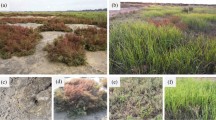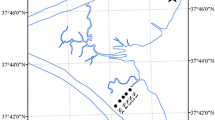Abstract
There are many different and even controversial results concerning the effects of Tamarisk on the physicochemical properties of soil. A year-round monitoring of soil salinity, pH and moisture is conducted beneath the Tamarisk shrub in a coastal wetland in the Bohai Sea in China, to ascertain the effects of Tamarisk on the physicochemical properties of soil in coastal wetland. Compared with the control area, the soil moisture content is lower around the area of the taproot when there is less precipitation in the growing season because of water consumption by Tamarisk shrub. However, the soil moisture content is higher around the taproot when there is more precipitation in the growing season or in the non-growing period because of water conservation by the rhizosphere. The absorption of salt by the Tamarisk shrub reduces the soil salinity temporarily, but eventually salt returns to the soil by the leaching of salt on leaves by rainfall or by fallen leaves. The annual average soil moisture content beneath the Tamarisk shrub is lower than the control area by only 6.4%, indicating that the Tamarisk shrub has little effect on drought or water conservation in soils in the temperate coastal wetland with moderate annual precipitation. The annual average salinity beneath the Tamarisk shrub is 18% greater than that of the control area, indicating that Tamarisk does have an effect of rising soil salinity around Tamarisk shrubs. The soil pH value is as low as 7.3 in summer and as high as 10.2 in winter. The pH of soil near the taproot of the Tamarisk shrubs is one pH unit lower than that in the control area during the growing season. The difference in pH is less different from the control area in the non-growing season, indicating that the Tamarisk shrub does have the effect of reducing the alkalinity of soil in coastal wetland.
Similar content being viewed by others
References
Bateman H L, Paxton E H. 2009. Saltcedar and Russian olive interactions with wildlife. In: Shafroth P B, Brown C A, Merritt D M, eds. Saltcedar and Russian olive Control Demonstration Act Science Assessment: U.S. Geological Survey Scientific Investigations Report, 5247: 49–63
Berry W L. 1970. Characteristics of salts secreted by Tamarix aphylla. American Journal of Botany, 57(10): 1226–1230
Brock J H. 1994. Tamarix spp. (salt cedar), an invasive exotic woody plant in arid and semi-arid riparian habitats of western USA. In: de Waal L C, Child L E, Wade P M, et al., eds. Ecology and Management of Invasive Riverside Plants. Chichester: John Wiley & Sons Ltd, 27–44
Busch D E, Smith S D. 1993. Effects of fire on water and salinity relations of riparian woody taxa. Oecologia, 94(2): 186–194
Campbell C J, Dick-Peddie W A. 1964. Comparison of phreatophyte communities on the Rio Grande in New Mexico. Ecology, 45(3): 492–502
Decker J P. 1961. Salt secretion by Tamarix pentandra pall. Forest Science, 7(3): 214–217
Di Tomaso J M. 1998. Impact, biology, and ecology of saltcedar (Tamarix spp.) in the southwestern United States. Weed Technology, 12(2): 326–336
Everitt B L. 1980. Ecology of saltcedar—A plea for research. Environmental Geology, 3(2): 77–84
Everitt B L. 1998. Chronology of the spread of tamarisk in the central Rio Grande. Wetlands, 18(4): 658–668
Gay L W, Fritschen L J. 1979. An energy budget analysis of water use by saltcedar. Water Resources Research, 15(6): 1589–1592
Glenn E, Tanner R, Mendez S, et al. 1998. Growth rates, salt tolerance and water use characteristics of native and invasive riparian plants from the delta of the Colorado River, Mexico. Journal of Arid Environments, 40(3): 281–294
Grubb R T, Sheley R L, Carlstrom R D. 1997. Saltcedar (tamarisk). Bozeman: Montana State University Extension Service MT9710
Guan Hongbin, Wand Xiaolan, Ju Di. 2009. Soiled modification and application of Tamarix chinensis on the saline soil. Resource Development & Market (in Chinese), 25(10): 918–921
Hem J D. 1967. Composition of saline residues on leaves and stems of saltcedar (Tamarix pentandra Pallas): Analyses of saline deposits leached or washed from saltcedar plants. Washington DC: U.S. Government Printing Office
Hinsinger P, Plassard C, Tang C X, et al. 2003. Origins of root-mediated pH changes in the rhizosphere and their responses to environmental constraints: a review. Plant and Soil, 248(1–2): 43–59
Horton J L, Clark J L. 2001. Water table decline alters growth and survival of Salix gooddingii and Tamarix chinensis seedlings. Forest Ecology and Management, 140(2–3): 239–247
Ladenburger C G, Hild A L, Kazmer D J, et al. 2006. Soil salinity patterns in Tamarix invasions in the Bighorn Basin, Wyoming, USA. Journal of Arid Environments, 65(1): 111–128
Lesica P, DeLuca T H. 2004. Is tamarisk allelopathic?. Plant and Soil, 267(1–2): 357–365
Liu Chunjiang. 2006. The application of Tamarisk resources in the coastal shelter forest construction of the Yellow River delta argillaceous. Protection Forest Science and Technology (in Chinese), (2): 42–43, 61
Merritt D M, Shafroth P B. 2012. Edaphic, salinity, and stand structural trends in chronosequences of native and non-native dominated riparian forests along the Colorado River, USA. Biological Invasions, 14(12): 2665–2685
Nagler P L, Glenn E P, Jarnevich C S, et al. 2011. Distribution and abundance of saltcedar and Russian olive in the western United States. Critical Reviews in Plant Sciences, 30(6): 508–523
Robinson T W. 1965. Introduction, Spread, and Aerial Extent of Saltcedar (Tarmarix) in the Western States: U. S. Geological Survey Professional Papers, 491-A, 12
Sexton J P. 2000. Invasive potential of Tamarix ramosissima (saltcedar) in continental climates of North America [dissertation]. Missoula, MT, USA: University of Montana
Shafroth P B, Friedman J M, Ischinger L S. 1995. Effects of salinity on establishment of Populus fremontii (cottonwood) and Tamarix ramosissima (saltcedar) in southwestern United States. Great Basin Naturalist, 55(1): 58–65
Smith S D, Devitt D A, Sala A, et al. 1998. Water relations of riparian plants from warm desert regions. Wetlands, 18(4): 687–696
Stromberg J C. 1998. Functional equivalency of saltcedar (Tamarix chinensis) and fremont cottonwood (Populus fremonth) along a free-flowing river. Wetlands, 18(4): 675–686
Stromberg J C, Chew M K, Nagler P L, et al. 2009. Changing perceptions of change: the role of scientists in Tamarix and river management. Restoration Ecology, 17(2): 177–186
Thomson W W, Berry W L, Liu L L. 1969. Localization and secretion of salt by the salt glands of Tamarix aphylla. Proceedings of the National Academy of Sciences of the United States of America, 63(2): 310–317
Titus J H, Nowak R S, Smith S D. 2002. Soil resource heterogeneity in the Mojave Desert. Journal of Arid Environments, 52(3): 269–292
Vandersande M W, Glenn E P, Walworth J L. 2001. Tolerance of five riparian plants from the lower Colorado River to salinity drought and inundation. Journal of Arid Environments, 49(1): 147–159
Waisel Y. 1991. The glands of Tamarix aphylla: a system for salt recretion or for carbon concentration. Physiologia Plantarum, 83(3): 506–510
Wang Yulong, Li Zhige, Zhang Feng, et al. 2004. Research on soil profile beneath Tamarisk forest. Inner Mongolia Forestry Investigation and Design (in Chinese), 27(S1): 71–72
Wang Yuzhen, Liu Yongxin, Wei Chunlan, et al. 2006. Improvement of salt-affected soils with six halophytes. Journal of Anhui Agricultural Sciences (in Chinese), 34(5): 951–952, 957
Wang Liyan, Pan Jie, Xiao Hui, et al. 2012. Effect of planting salt-tolerant plants on water-soluble salt in coastal saline soil. Chinese Agricultural Science Bulletin (in Chinese), 28(20): 250–254
Wang Zhenyu, Zhao Fangfang, Zhang Baoguo, et al. 2010. Rhizosphere effect of three halophytes in the Yellow River Delta on nitrogen and phosphorus. Environmental Science & Technology (in Chinese), 33(10): 33–38
Yi Liangpeng, Ma Jian, Li Yan. 2007. Soil salt and nutrient concentration in the rhizosphere of desert halophytes. Acta Ecologica Sinica, 27(9): 3565–3571
Author information
Authors and Affiliations
Corresponding author
Additional information
Foundation item: The Public Science and Technology Research Funds Projects of Ocean under contract No. 201205008.
Rights and permissions
About this article
Cite this article
He, X., Wang, B., Xie, L. et al. Effects of Tamarisk shrub on physicochemical properties of soil in coastal wetland of the Bohai Sea. Acta Oceanol. Sin. 35, 106–112 (2016). https://doi.org/10.1007/s13131-016-0851-8
Received:
Accepted:
Published:
Issue Date:
DOI: https://doi.org/10.1007/s13131-016-0851-8




